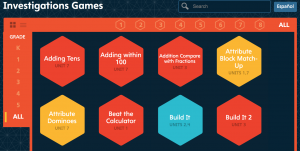Overview
Fifth grade in the Common Core is when students finish having arithmetic as a focus, though in later grades there will be plenty of opportunity to continue practicing these skill.
This year students will learn to add fractions. From their work in 3rd and 4th grade, students will have a firm grounding in the number line, in renaming fractions (e.g. 2/3 is also 4/6 ) and in adding fractions with the same denominator ( 3/8+2/8=5/8 ). All of this will make addition of fractions a process that makes sense rather than something to remember using tricks which use pictures of X’s or butterfly wings.
This type of reasoning also helps to apply fraction arithmetic correctly. Many of us remember that to multiply 2/3×3/5. you “multiply across,” but struggle to know if one should multiply in a real world context. A key is that 2/3×4/5. is what you get when you split 4/5 of something into three equal pieces and take two of those. Students will use pictures to reason about problems, as many good problem-solvers often do. From these they will be able to know whether to multiply or divide, and have a sense for what a reasonable answer should be.
Students will use similar reasoning about whole numbers and decimals—using sketches, examples, and properties which have been carefully developed, so these arithmetic skills will provide a strong base for algebra.
|


